Economics Assignment: Market Structures in the US Bicycle Market
VerifiedAdded on 2020/03/01
|12
|5242
|142
Essay
AI Summary
This economics assignment delves into the intricacies of market structures, specifically focusing on perfect competition, monopolistic competition, and monopoly, with a detailed case study of the U.S. bicycle market. The assignment begins by defining and outlining the characteristics of a perfectly competitive market, emphasizing the roles of numerous buyers and sellers, the absence of barriers to entry, and the prevalence of price takers. It then applies these concepts to the bicycle market, examining the competitive landscape in Madison, Wisconsin, highlighting the presence of multiple retailers and the potential for maximizing output and minimizing prices. The assignment also acknowledges the limitations of perfect competition, such as information asymmetry. Furthermore, the assignment explores monopolistically competitive markets, contrasting them with perfect competition and monopoly. It explains product differentiation, selling costs, and the impact of brand loyalty. The assignment analyzes how the bicycle market could evolve into a monopolistically competitive structure through product differentiation and marketing strategies. The assignment also discusses the impact of unemployment and wage rates on business operations. Finally, the assignment concludes by summarizing the key aspects of different market structures and the factors influencing business operations within an economy.
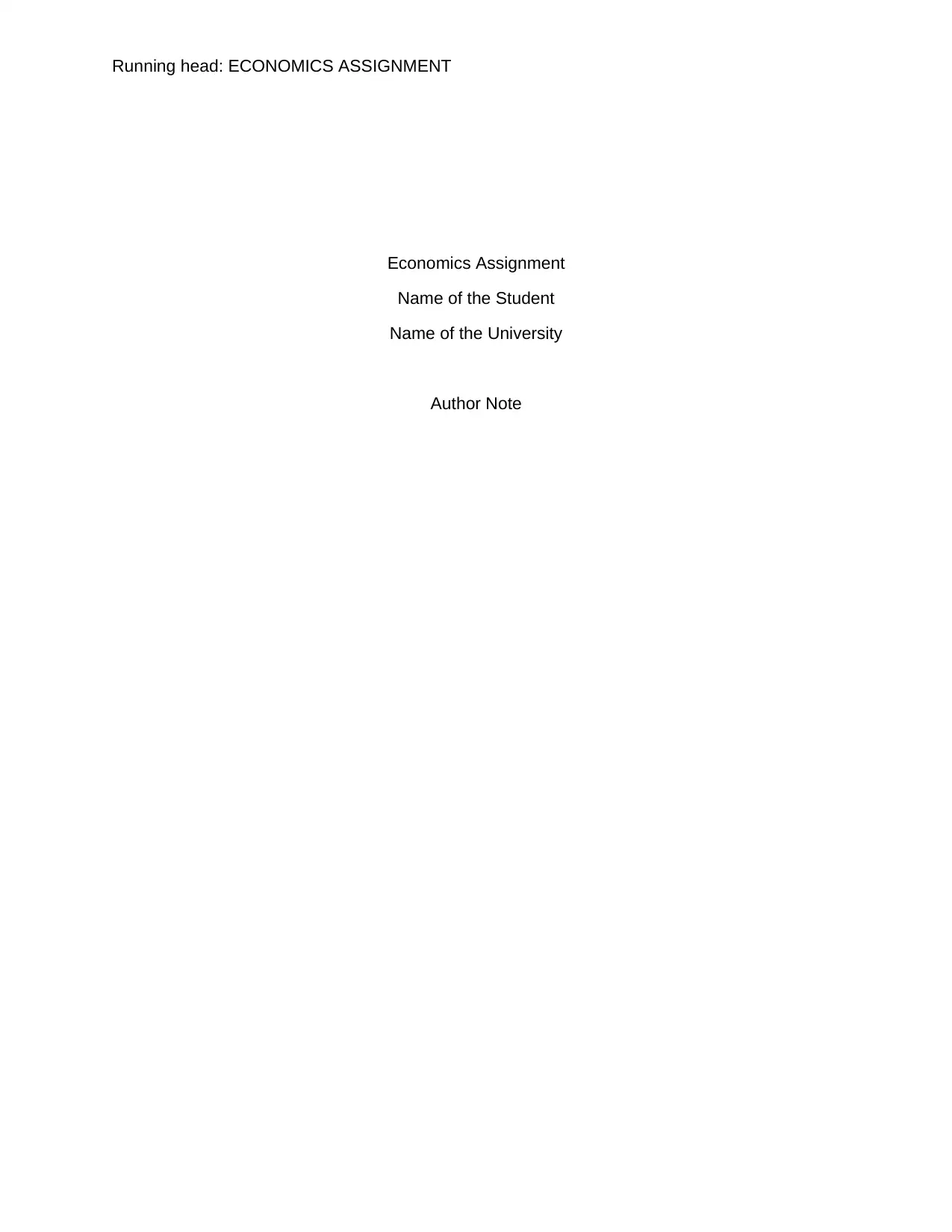
Running head: ECONOMICS ASSIGNMENT
Economics Assignment
Name of the Student
Name of the University
Author Note
Economics Assignment
Name of the Student
Name of the University
Author Note
Paraphrase This Document
Need a fresh take? Get an instant paraphrase of this document with our AI Paraphraser
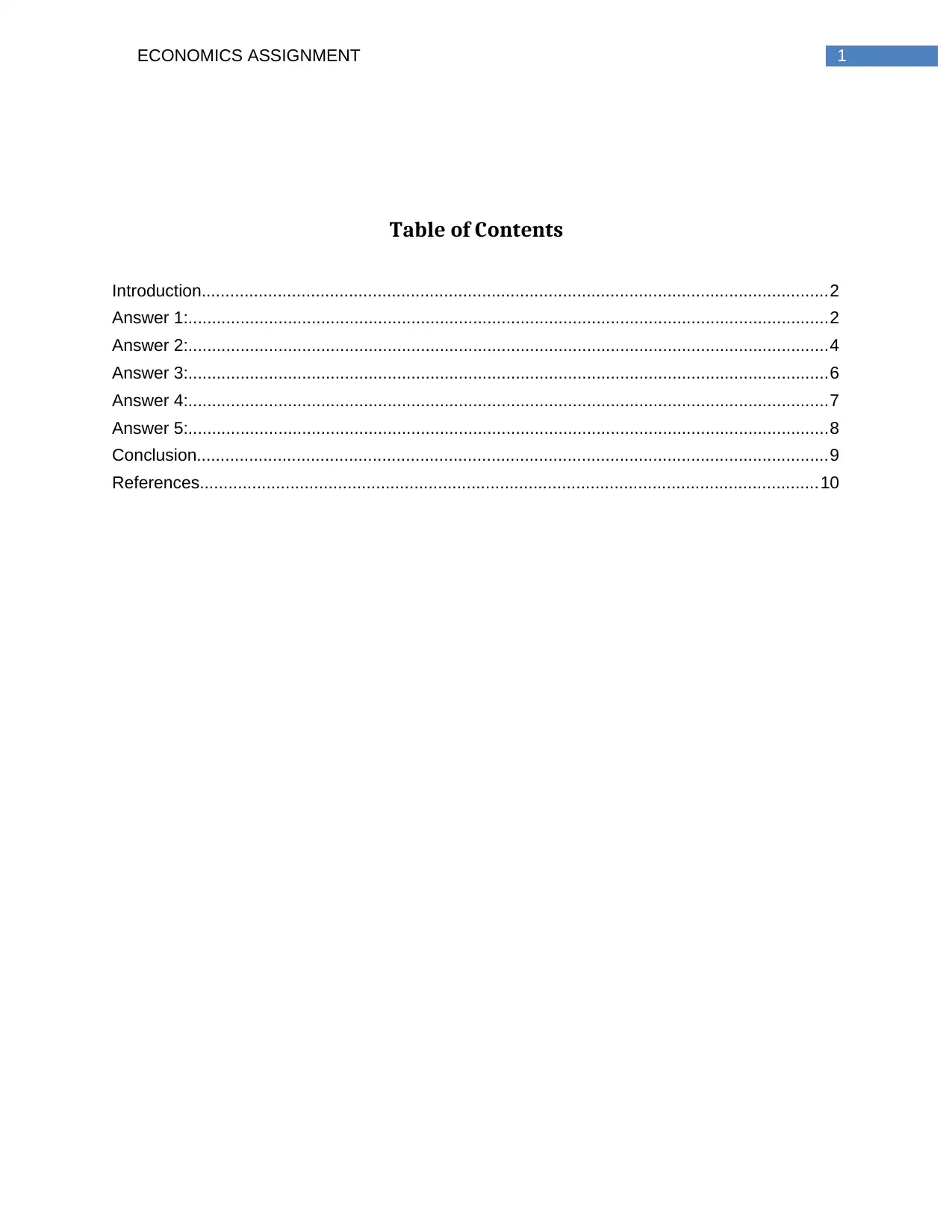
1ECONOMICS ASSIGNMENT
Table of Contents
Introduction....................................................................................................................................2
Answer 1:.......................................................................................................................................2
Answer 2:.......................................................................................................................................4
Answer 3:.......................................................................................................................................6
Answer 4:.......................................................................................................................................7
Answer 5:.......................................................................................................................................8
Conclusion.....................................................................................................................................9
References..................................................................................................................................10
Table of Contents
Introduction....................................................................................................................................2
Answer 1:.......................................................................................................................................2
Answer 2:.......................................................................................................................................4
Answer 3:.......................................................................................................................................6
Answer 4:.......................................................................................................................................7
Answer 5:.......................................................................................................................................8
Conclusion.....................................................................................................................................9
References..................................................................................................................................10
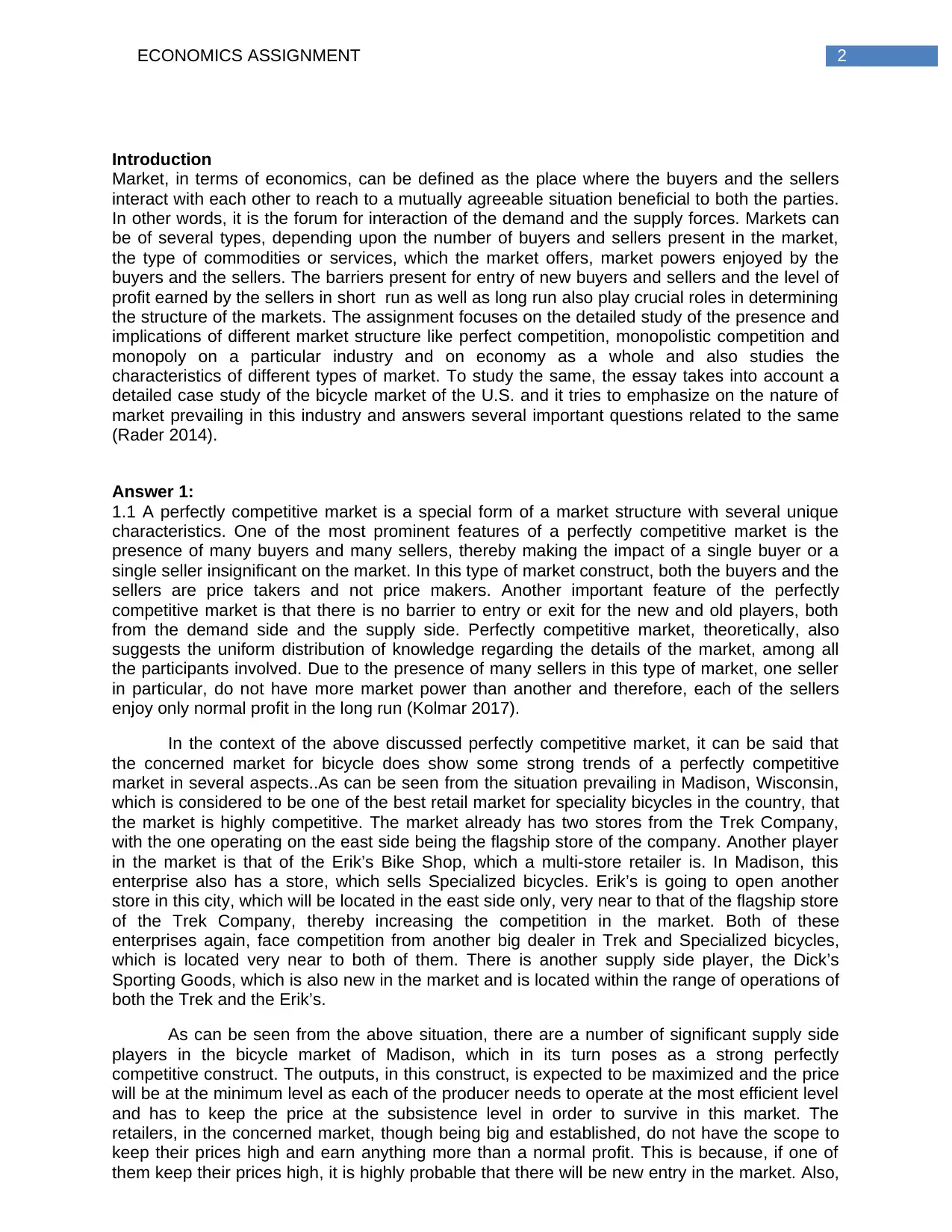
2ECONOMICS ASSIGNMENT
Introduction
Market, in terms of economics, can be defined as the place where the buyers and the sellers
interact with each other to reach to a mutually agreeable situation beneficial to both the parties.
In other words, it is the forum for interaction of the demand and the supply forces. Markets can
be of several types, depending upon the number of buyers and sellers present in the market,
the type of commodities or services, which the market offers, market powers enjoyed by the
buyers and the sellers. The barriers present for entry of new buyers and sellers and the level of
profit earned by the sellers in short run as well as long run also play crucial roles in determining
the structure of the markets. The assignment focuses on the detailed study of the presence and
implications of different market structure like perfect competition, monopolistic competition and
monopoly on a particular industry and on economy as a whole and also studies the
characteristics of different types of market. To study the same, the essay takes into account a
detailed case study of the bicycle market of the U.S. and it tries to emphasize on the nature of
market prevailing in this industry and answers several important questions related to the same
(Rader 2014).
Answer 1:
1.1 A perfectly competitive market is a special form of a market structure with several unique
characteristics. One of the most prominent features of a perfectly competitive market is the
presence of many buyers and many sellers, thereby making the impact of a single buyer or a
single seller insignificant on the market. In this type of market construct, both the buyers and the
sellers are price takers and not price makers. Another important feature of the perfectly
competitive market is that there is no barrier to entry or exit for the new and old players, both
from the demand side and the supply side. Perfectly competitive market, theoretically, also
suggests the uniform distribution of knowledge regarding the details of the market, among all
the participants involved. Due to the presence of many sellers in this type of market, one seller
in particular, do not have more market power than another and therefore, each of the sellers
enjoy only normal profit in the long run (Kolmar 2017).
In the context of the above discussed perfectly competitive market, it can be said that
the concerned market for bicycle does show some strong trends of a perfectly competitive
market in several aspects..As can be seen from the situation prevailing in Madison, Wisconsin,
which is considered to be one of the best retail market for speciality bicycles in the country, that
the market is highly competitive. The market already has two stores from the Trek Company,
with the one operating on the east side being the flagship store of the company. Another player
in the market is that of the Erik’s Bike Shop, which a multi-store retailer is. In Madison, this
enterprise also has a store, which sells Specialized bicycles. Erik’s is going to open another
store in this city, which will be located in the east side only, very near to that of the flagship store
of the Trek Company, thereby increasing the competition in the market. Both of these
enterprises again, face competition from another big dealer in Trek and Specialized bicycles,
which is located very near to both of them. There is another supply side player, the Dick’s
Sporting Goods, which is also new in the market and is located within the range of operations of
both the Trek and the Erik’s.
As can be seen from the above situation, there are a number of significant supply side
players in the bicycle market of Madison, which in its turn poses as a strong perfectly
competitive construct. The outputs, in this construct, is expected to be maximized and the price
will be at the minimum level as each of the producer needs to operate at the most efficient level
and has to keep the price at the subsistence level in order to survive in this market. The
retailers, in the concerned market, though being big and established, do not have the scope to
keep their prices high and earn anything more than a normal profit. This is because, if one of
them keep their prices high, it is highly probable that there will be new entry in the market. Also,
Introduction
Market, in terms of economics, can be defined as the place where the buyers and the sellers
interact with each other to reach to a mutually agreeable situation beneficial to both the parties.
In other words, it is the forum for interaction of the demand and the supply forces. Markets can
be of several types, depending upon the number of buyers and sellers present in the market,
the type of commodities or services, which the market offers, market powers enjoyed by the
buyers and the sellers. The barriers present for entry of new buyers and sellers and the level of
profit earned by the sellers in short run as well as long run also play crucial roles in determining
the structure of the markets. The assignment focuses on the detailed study of the presence and
implications of different market structure like perfect competition, monopolistic competition and
monopoly on a particular industry and on economy as a whole and also studies the
characteristics of different types of market. To study the same, the essay takes into account a
detailed case study of the bicycle market of the U.S. and it tries to emphasize on the nature of
market prevailing in this industry and answers several important questions related to the same
(Rader 2014).
Answer 1:
1.1 A perfectly competitive market is a special form of a market structure with several unique
characteristics. One of the most prominent features of a perfectly competitive market is the
presence of many buyers and many sellers, thereby making the impact of a single buyer or a
single seller insignificant on the market. In this type of market construct, both the buyers and the
sellers are price takers and not price makers. Another important feature of the perfectly
competitive market is that there is no barrier to entry or exit for the new and old players, both
from the demand side and the supply side. Perfectly competitive market, theoretically, also
suggests the uniform distribution of knowledge regarding the details of the market, among all
the participants involved. Due to the presence of many sellers in this type of market, one seller
in particular, do not have more market power than another and therefore, each of the sellers
enjoy only normal profit in the long run (Kolmar 2017).
In the context of the above discussed perfectly competitive market, it can be said that
the concerned market for bicycle does show some strong trends of a perfectly competitive
market in several aspects..As can be seen from the situation prevailing in Madison, Wisconsin,
which is considered to be one of the best retail market for speciality bicycles in the country, that
the market is highly competitive. The market already has two stores from the Trek Company,
with the one operating on the east side being the flagship store of the company. Another player
in the market is that of the Erik’s Bike Shop, which a multi-store retailer is. In Madison, this
enterprise also has a store, which sells Specialized bicycles. Erik’s is going to open another
store in this city, which will be located in the east side only, very near to that of the flagship store
of the Trek Company, thereby increasing the competition in the market. Both of these
enterprises again, face competition from another big dealer in Trek and Specialized bicycles,
which is located very near to both of them. There is another supply side player, the Dick’s
Sporting Goods, which is also new in the market and is located within the range of operations of
both the Trek and the Erik’s.
As can be seen from the above situation, there are a number of significant supply side
players in the bicycle market of Madison, which in its turn poses as a strong perfectly
competitive construct. The outputs, in this construct, is expected to be maximized and the price
will be at the minimum level as each of the producer needs to operate at the most efficient level
and has to keep the price at the subsistence level in order to survive in this market. The
retailers, in the concerned market, though being big and established, do not have the scope to
keep their prices high and earn anything more than a normal profit. This is because, if one of
them keep their prices high, it is highly probable that there will be new entry in the market. Also,
⊘ This is a preview!⊘
Do you want full access?
Subscribe today to unlock all pages.

Trusted by 1+ million students worldwide
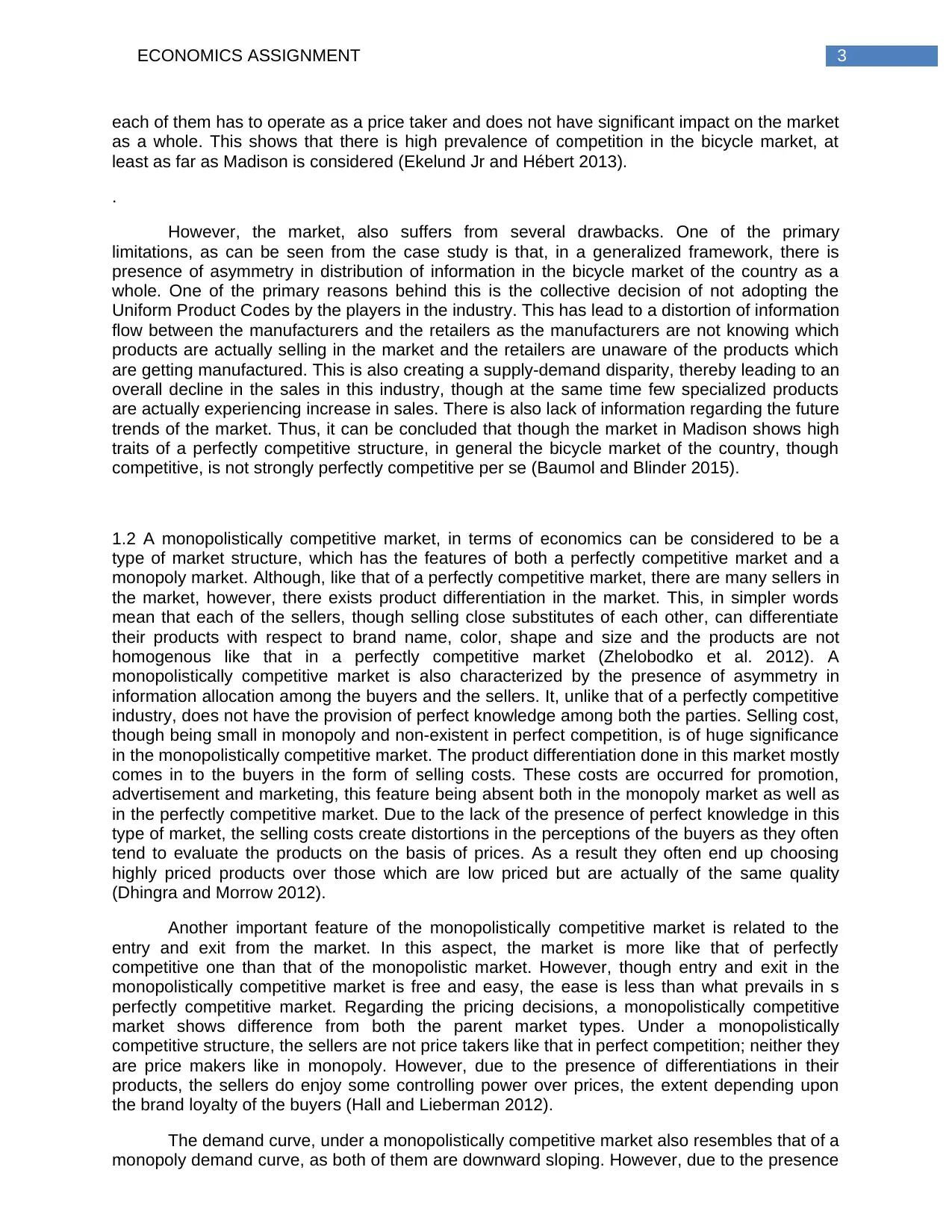
3ECONOMICS ASSIGNMENT
each of them has to operate as a price taker and does not have significant impact on the market
as a whole. This shows that there is high prevalence of competition in the bicycle market, at
least as far as Madison is considered (Ekelund Jr and Hébert 2013).
.
However, the market, also suffers from several drawbacks. One of the primary
limitations, as can be seen from the case study is that, in a generalized framework, there is
presence of asymmetry in distribution of information in the bicycle market of the country as a
whole. One of the primary reasons behind this is the collective decision of not adopting the
Uniform Product Codes by the players in the industry. This has lead to a distortion of information
flow between the manufacturers and the retailers as the manufacturers are not knowing which
products are actually selling in the market and the retailers are unaware of the products which
are getting manufactured. This is also creating a supply-demand disparity, thereby leading to an
overall decline in the sales in this industry, though at the same time few specialized products
are actually experiencing increase in sales. There is also lack of information regarding the future
trends of the market. Thus, it can be concluded that though the market in Madison shows high
traits of a perfectly competitive structure, in general the bicycle market of the country, though
competitive, is not strongly perfectly competitive per se (Baumol and Blinder 2015).
1.2 A monopolistically competitive market, in terms of economics can be considered to be a
type of market structure, which has the features of both a perfectly competitive market and a
monopoly market. Although, like that of a perfectly competitive market, there are many sellers in
the market, however, there exists product differentiation in the market. This, in simpler words
mean that each of the sellers, though selling close substitutes of each other, can differentiate
their products with respect to brand name, color, shape and size and the products are not
homogenous like that in a perfectly competitive market (Zhelobodko et al. 2012). A
monopolistically competitive market is also characterized by the presence of asymmetry in
information allocation among the buyers and the sellers. It, unlike that of a perfectly competitive
industry, does not have the provision of perfect knowledge among both the parties. Selling cost,
though being small in monopoly and non-existent in perfect competition, is of huge significance
in the monopolistically competitive market. The product differentiation done in this market mostly
comes in to the buyers in the form of selling costs. These costs are occurred for promotion,
advertisement and marketing, this feature being absent both in the monopoly market as well as
in the perfectly competitive market. Due to the lack of the presence of perfect knowledge in this
type of market, the selling costs create distortions in the perceptions of the buyers as they often
tend to evaluate the products on the basis of prices. As a result they often end up choosing
highly priced products over those which are low priced but are actually of the same quality
(Dhingra and Morrow 2012).
Another important feature of the monopolistically competitive market is related to the
entry and exit from the market. In this aspect, the market is more like that of perfectly
competitive one than that of the monopolistic market. However, though entry and exit in the
monopolistically competitive market is free and easy, the ease is less than what prevails in s
perfectly competitive market. Regarding the pricing decisions, a monopolistically competitive
market shows difference from both the parent market types. Under a monopolistically
competitive structure, the sellers are not price takers like that in perfect competition; neither they
are price makers like in monopoly. However, due to the presence of differentiations in their
products, the sellers do enjoy some controlling power over prices, the extent depending upon
the brand loyalty of the buyers (Hall and Lieberman 2012).
The demand curve, under a monopolistically competitive market also resembles that of a
monopoly demand curve, as both of them are downward sloping. However, due to the presence
each of them has to operate as a price taker and does not have significant impact on the market
as a whole. This shows that there is high prevalence of competition in the bicycle market, at
least as far as Madison is considered (Ekelund Jr and Hébert 2013).
.
However, the market, also suffers from several drawbacks. One of the primary
limitations, as can be seen from the case study is that, in a generalized framework, there is
presence of asymmetry in distribution of information in the bicycle market of the country as a
whole. One of the primary reasons behind this is the collective decision of not adopting the
Uniform Product Codes by the players in the industry. This has lead to a distortion of information
flow between the manufacturers and the retailers as the manufacturers are not knowing which
products are actually selling in the market and the retailers are unaware of the products which
are getting manufactured. This is also creating a supply-demand disparity, thereby leading to an
overall decline in the sales in this industry, though at the same time few specialized products
are actually experiencing increase in sales. There is also lack of information regarding the future
trends of the market. Thus, it can be concluded that though the market in Madison shows high
traits of a perfectly competitive structure, in general the bicycle market of the country, though
competitive, is not strongly perfectly competitive per se (Baumol and Blinder 2015).
1.2 A monopolistically competitive market, in terms of economics can be considered to be a
type of market structure, which has the features of both a perfectly competitive market and a
monopoly market. Although, like that of a perfectly competitive market, there are many sellers in
the market, however, there exists product differentiation in the market. This, in simpler words
mean that each of the sellers, though selling close substitutes of each other, can differentiate
their products with respect to brand name, color, shape and size and the products are not
homogenous like that in a perfectly competitive market (Zhelobodko et al. 2012). A
monopolistically competitive market is also characterized by the presence of asymmetry in
information allocation among the buyers and the sellers. It, unlike that of a perfectly competitive
industry, does not have the provision of perfect knowledge among both the parties. Selling cost,
though being small in monopoly and non-existent in perfect competition, is of huge significance
in the monopolistically competitive market. The product differentiation done in this market mostly
comes in to the buyers in the form of selling costs. These costs are occurred for promotion,
advertisement and marketing, this feature being absent both in the monopoly market as well as
in the perfectly competitive market. Due to the lack of the presence of perfect knowledge in this
type of market, the selling costs create distortions in the perceptions of the buyers as they often
tend to evaluate the products on the basis of prices. As a result they often end up choosing
highly priced products over those which are low priced but are actually of the same quality
(Dhingra and Morrow 2012).
Another important feature of the monopolistically competitive market is related to the
entry and exit from the market. In this aspect, the market is more like that of perfectly
competitive one than that of the monopolistic market. However, though entry and exit in the
monopolistically competitive market is free and easy, the ease is less than what prevails in s
perfectly competitive market. Regarding the pricing decisions, a monopolistically competitive
market shows difference from both the parent market types. Under a monopolistically
competitive structure, the sellers are not price takers like that in perfect competition; neither they
are price makers like in monopoly. However, due to the presence of differentiations in their
products, the sellers do enjoy some controlling power over prices, the extent depending upon
the brand loyalty of the buyers (Hall and Lieberman 2012).
The demand curve, under a monopolistically competitive market also resembles that of a
monopoly demand curve, as both of them are downward sloping. However, due to the presence
Paraphrase This Document
Need a fresh take? Get an instant paraphrase of this document with our AI Paraphraser
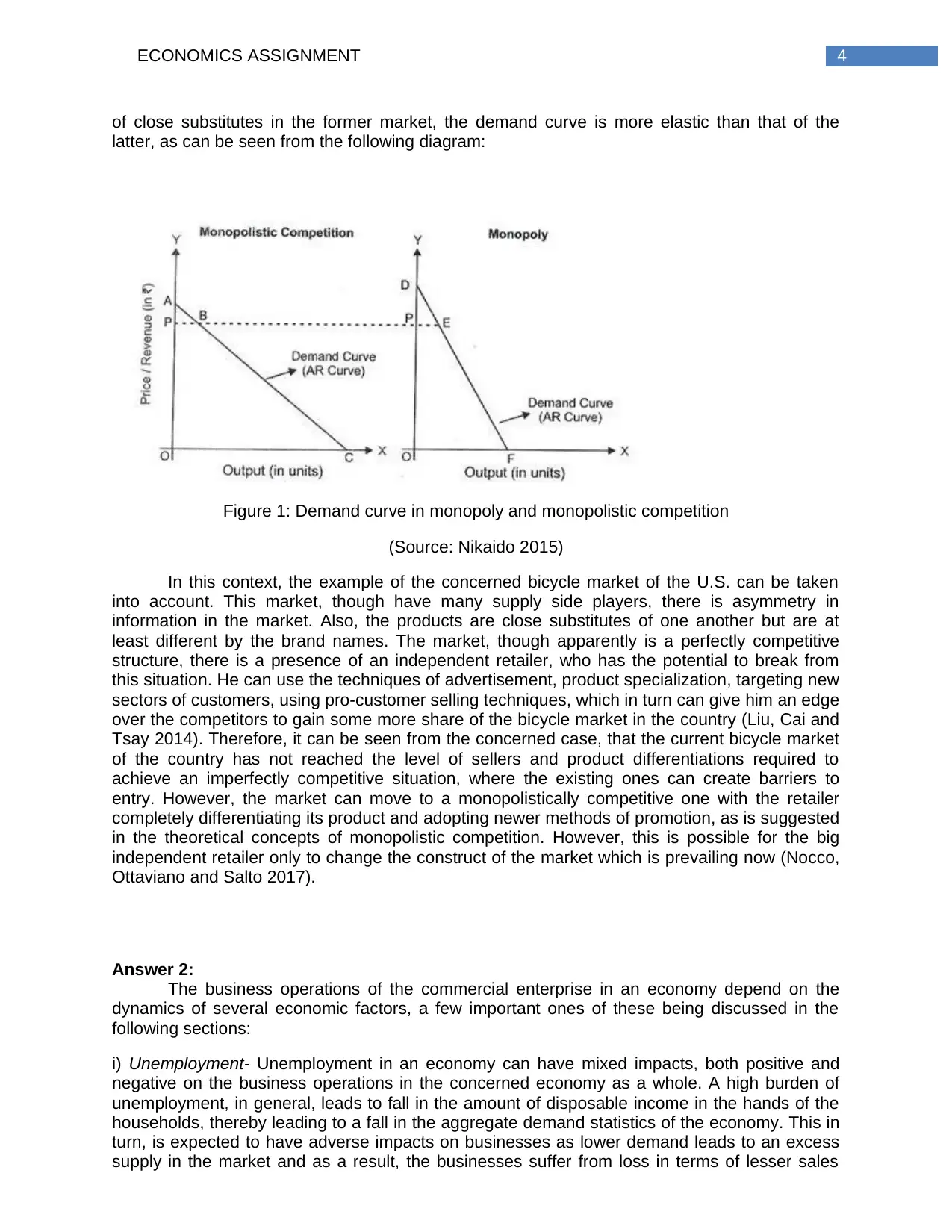
4ECONOMICS ASSIGNMENT
of close substitutes in the former market, the demand curve is more elastic than that of the
latter, as can be seen from the following diagram:
Figure 1: Demand curve in monopoly and monopolistic competition
(Source: Nikaido 2015)
In this context, the example of the concerned bicycle market of the U.S. can be taken
into account. This market, though have many supply side players, there is asymmetry in
information in the market. Also, the products are close substitutes of one another but are at
least different by the brand names. The market, though apparently is a perfectly competitive
structure, there is a presence of an independent retailer, who has the potential to break from
this situation. He can use the techniques of advertisement, product specialization, targeting new
sectors of customers, using pro-customer selling techniques, which in turn can give him an edge
over the competitors to gain some more share of the bicycle market in the country (Liu, Cai and
Tsay 2014). Therefore, it can be seen from the concerned case, that the current bicycle market
of the country has not reached the level of sellers and product differentiations required to
achieve an imperfectly competitive situation, where the existing ones can create barriers to
entry. However, the market can move to a monopolistically competitive one with the retailer
completely differentiating its product and adopting newer methods of promotion, as is suggested
in the theoretical concepts of monopolistic competition. However, this is possible for the big
independent retailer only to change the construct of the market which is prevailing now (Nocco,
Ottaviano and Salto 2017).
Answer 2:
The business operations of the commercial enterprise in an economy depend on the
dynamics of several economic factors, a few important ones of these being discussed in the
following sections:
i) Unemployment- Unemployment in an economy can have mixed impacts, both positive and
negative on the business operations in the concerned economy as a whole. A high burden of
unemployment, in general, leads to fall in the amount of disposable income in the hands of the
households, thereby leading to a fall in the aggregate demand statistics of the economy. This in
turn, is expected to have adverse impacts on businesses as lower demand leads to an excess
supply in the market and as a result, the businesses suffer from loss in terms of lesser sales
of close substitutes in the former market, the demand curve is more elastic than that of the
latter, as can be seen from the following diagram:
Figure 1: Demand curve in monopoly and monopolistic competition
(Source: Nikaido 2015)
In this context, the example of the concerned bicycle market of the U.S. can be taken
into account. This market, though have many supply side players, there is asymmetry in
information in the market. Also, the products are close substitutes of one another but are at
least different by the brand names. The market, though apparently is a perfectly competitive
structure, there is a presence of an independent retailer, who has the potential to break from
this situation. He can use the techniques of advertisement, product specialization, targeting new
sectors of customers, using pro-customer selling techniques, which in turn can give him an edge
over the competitors to gain some more share of the bicycle market in the country (Liu, Cai and
Tsay 2014). Therefore, it can be seen from the concerned case, that the current bicycle market
of the country has not reached the level of sellers and product differentiations required to
achieve an imperfectly competitive situation, where the existing ones can create barriers to
entry. However, the market can move to a monopolistically competitive one with the retailer
completely differentiating its product and adopting newer methods of promotion, as is suggested
in the theoretical concepts of monopolistic competition. However, this is possible for the big
independent retailer only to change the construct of the market which is prevailing now (Nocco,
Ottaviano and Salto 2017).
Answer 2:
The business operations of the commercial enterprise in an economy depend on the
dynamics of several economic factors, a few important ones of these being discussed in the
following sections:
i) Unemployment- Unemployment in an economy can have mixed impacts, both positive and
negative on the business operations in the concerned economy as a whole. A high burden of
unemployment, in general, leads to fall in the amount of disposable income in the hands of the
households, thereby leading to a fall in the aggregate demand statistics of the economy. This in
turn, is expected to have adverse impacts on businesses as lower demand leads to an excess
supply in the market and as a result, the businesses suffer from loss in terms of lesser sales
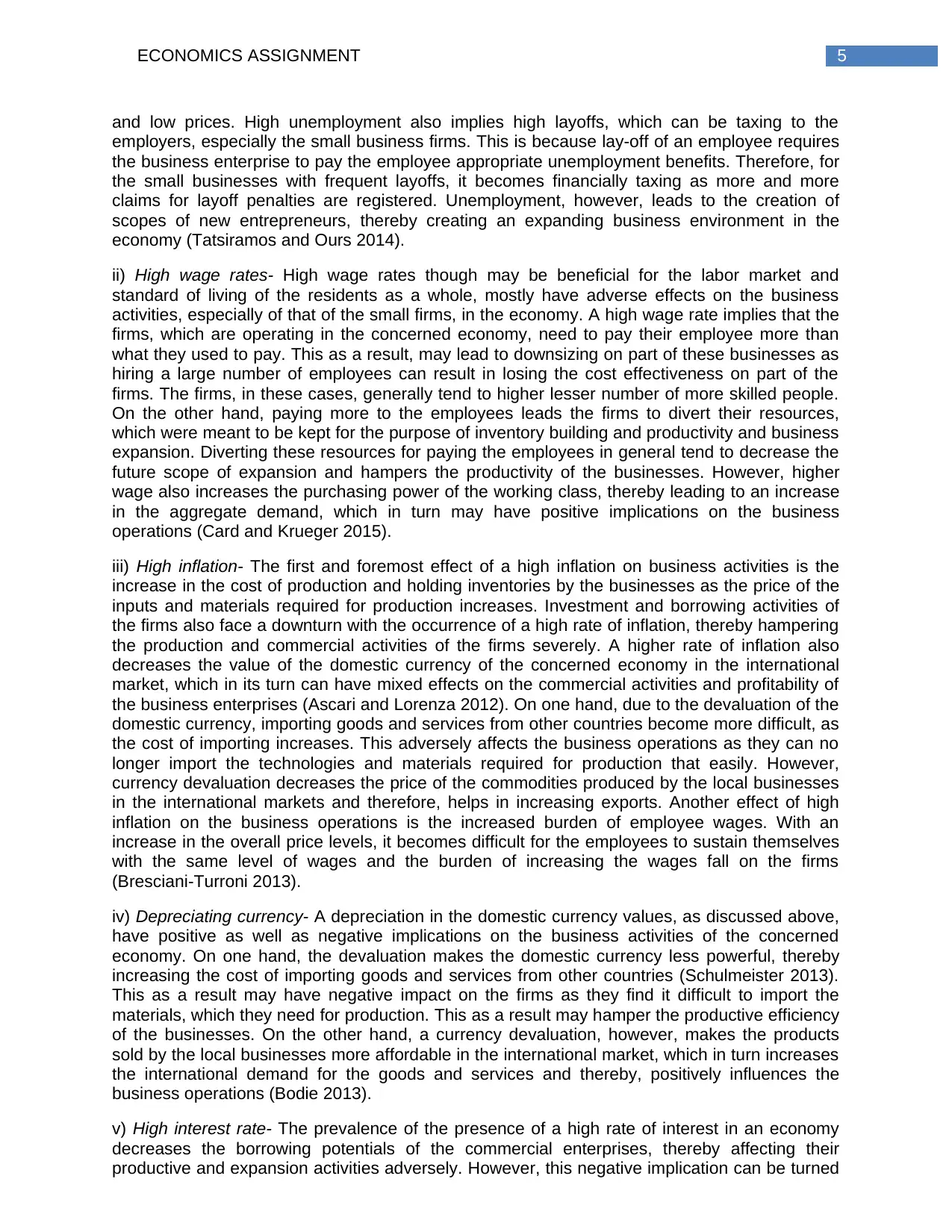
5ECONOMICS ASSIGNMENT
and low prices. High unemployment also implies high layoffs, which can be taxing to the
employers, especially the small business firms. This is because lay-off of an employee requires
the business enterprise to pay the employee appropriate unemployment benefits. Therefore, for
the small businesses with frequent layoffs, it becomes financially taxing as more and more
claims for layoff penalties are registered. Unemployment, however, leads to the creation of
scopes of new entrepreneurs, thereby creating an expanding business environment in the
economy (Tatsiramos and Ours 2014).
ii) High wage rates- High wage rates though may be beneficial for the labor market and
standard of living of the residents as a whole, mostly have adverse effects on the business
activities, especially of that of the small firms, in the economy. A high wage rate implies that the
firms, which are operating in the concerned economy, need to pay their employee more than
what they used to pay. This as a result, may lead to downsizing on part of these businesses as
hiring a large number of employees can result in losing the cost effectiveness on part of the
firms. The firms, in these cases, generally tend to higher lesser number of more skilled people.
On the other hand, paying more to the employees leads the firms to divert their resources,
which were meant to be kept for the purpose of inventory building and productivity and business
expansion. Diverting these resources for paying the employees in general tend to decrease the
future scope of expansion and hampers the productivity of the businesses. However, higher
wage also increases the purchasing power of the working class, thereby leading to an increase
in the aggregate demand, which in turn may have positive implications on the business
operations (Card and Krueger 2015).
iii) High inflation- The first and foremost effect of a high inflation on business activities is the
increase in the cost of production and holding inventories by the businesses as the price of the
inputs and materials required for production increases. Investment and borrowing activities of
the firms also face a downturn with the occurrence of a high rate of inflation, thereby hampering
the production and commercial activities of the firms severely. A higher rate of inflation also
decreases the value of the domestic currency of the concerned economy in the international
market, which in its turn can have mixed effects on the commercial activities and profitability of
the business enterprises (Ascari and Lorenza 2012). On one hand, due to the devaluation of the
domestic currency, importing goods and services from other countries become more difficult, as
the cost of importing increases. This adversely affects the business operations as they can no
longer import the technologies and materials required for production that easily. However,
currency devaluation decreases the price of the commodities produced by the local businesses
in the international markets and therefore, helps in increasing exports. Another effect of high
inflation on the business operations is the increased burden of employee wages. With an
increase in the overall price levels, it becomes difficult for the employees to sustain themselves
with the same level of wages and the burden of increasing the wages fall on the firms
(Bresciani-Turroni 2013).
iv) Depreciating currency- A depreciation in the domestic currency values, as discussed above,
have positive as well as negative implications on the business activities of the concerned
economy. On one hand, the devaluation makes the domestic currency less powerful, thereby
increasing the cost of importing goods and services from other countries (Schulmeister 2013).
This as a result may have negative impact on the firms as they find it difficult to import the
materials, which they need for production. This as a result may hamper the productive efficiency
of the businesses. On the other hand, a currency devaluation, however, makes the products
sold by the local businesses more affordable in the international market, which in turn increases
the international demand for the goods and services and thereby, positively influences the
business operations (Bodie 2013).
v) High interest rate- The prevalence of the presence of a high rate of interest in an economy
decreases the borrowing potentials of the commercial enterprises, thereby affecting their
productive and expansion activities adversely. However, this negative implication can be turned
and low prices. High unemployment also implies high layoffs, which can be taxing to the
employers, especially the small business firms. This is because lay-off of an employee requires
the business enterprise to pay the employee appropriate unemployment benefits. Therefore, for
the small businesses with frequent layoffs, it becomes financially taxing as more and more
claims for layoff penalties are registered. Unemployment, however, leads to the creation of
scopes of new entrepreneurs, thereby creating an expanding business environment in the
economy (Tatsiramos and Ours 2014).
ii) High wage rates- High wage rates though may be beneficial for the labor market and
standard of living of the residents as a whole, mostly have adverse effects on the business
activities, especially of that of the small firms, in the economy. A high wage rate implies that the
firms, which are operating in the concerned economy, need to pay their employee more than
what they used to pay. This as a result, may lead to downsizing on part of these businesses as
hiring a large number of employees can result in losing the cost effectiveness on part of the
firms. The firms, in these cases, generally tend to higher lesser number of more skilled people.
On the other hand, paying more to the employees leads the firms to divert their resources,
which were meant to be kept for the purpose of inventory building and productivity and business
expansion. Diverting these resources for paying the employees in general tend to decrease the
future scope of expansion and hampers the productivity of the businesses. However, higher
wage also increases the purchasing power of the working class, thereby leading to an increase
in the aggregate demand, which in turn may have positive implications on the business
operations (Card and Krueger 2015).
iii) High inflation- The first and foremost effect of a high inflation on business activities is the
increase in the cost of production and holding inventories by the businesses as the price of the
inputs and materials required for production increases. Investment and borrowing activities of
the firms also face a downturn with the occurrence of a high rate of inflation, thereby hampering
the production and commercial activities of the firms severely. A higher rate of inflation also
decreases the value of the domestic currency of the concerned economy in the international
market, which in its turn can have mixed effects on the commercial activities and profitability of
the business enterprises (Ascari and Lorenza 2012). On one hand, due to the devaluation of the
domestic currency, importing goods and services from other countries become more difficult, as
the cost of importing increases. This adversely affects the business operations as they can no
longer import the technologies and materials required for production that easily. However,
currency devaluation decreases the price of the commodities produced by the local businesses
in the international markets and therefore, helps in increasing exports. Another effect of high
inflation on the business operations is the increased burden of employee wages. With an
increase in the overall price levels, it becomes difficult for the employees to sustain themselves
with the same level of wages and the burden of increasing the wages fall on the firms
(Bresciani-Turroni 2013).
iv) Depreciating currency- A depreciation in the domestic currency values, as discussed above,
have positive as well as negative implications on the business activities of the concerned
economy. On one hand, the devaluation makes the domestic currency less powerful, thereby
increasing the cost of importing goods and services from other countries (Schulmeister 2013).
This as a result may have negative impact on the firms as they find it difficult to import the
materials, which they need for production. This as a result may hamper the productive efficiency
of the businesses. On the other hand, a currency devaluation, however, makes the products
sold by the local businesses more affordable in the international market, which in turn increases
the international demand for the goods and services and thereby, positively influences the
business operations (Bodie 2013).
v) High interest rate- The prevalence of the presence of a high rate of interest in an economy
decreases the borrowing potentials of the commercial enterprises, thereby affecting their
productive and expansion activities adversely. However, this negative implication can be turned
⊘ This is a preview!⊘
Do you want full access?
Subscribe today to unlock all pages.

Trusted by 1+ million students worldwide
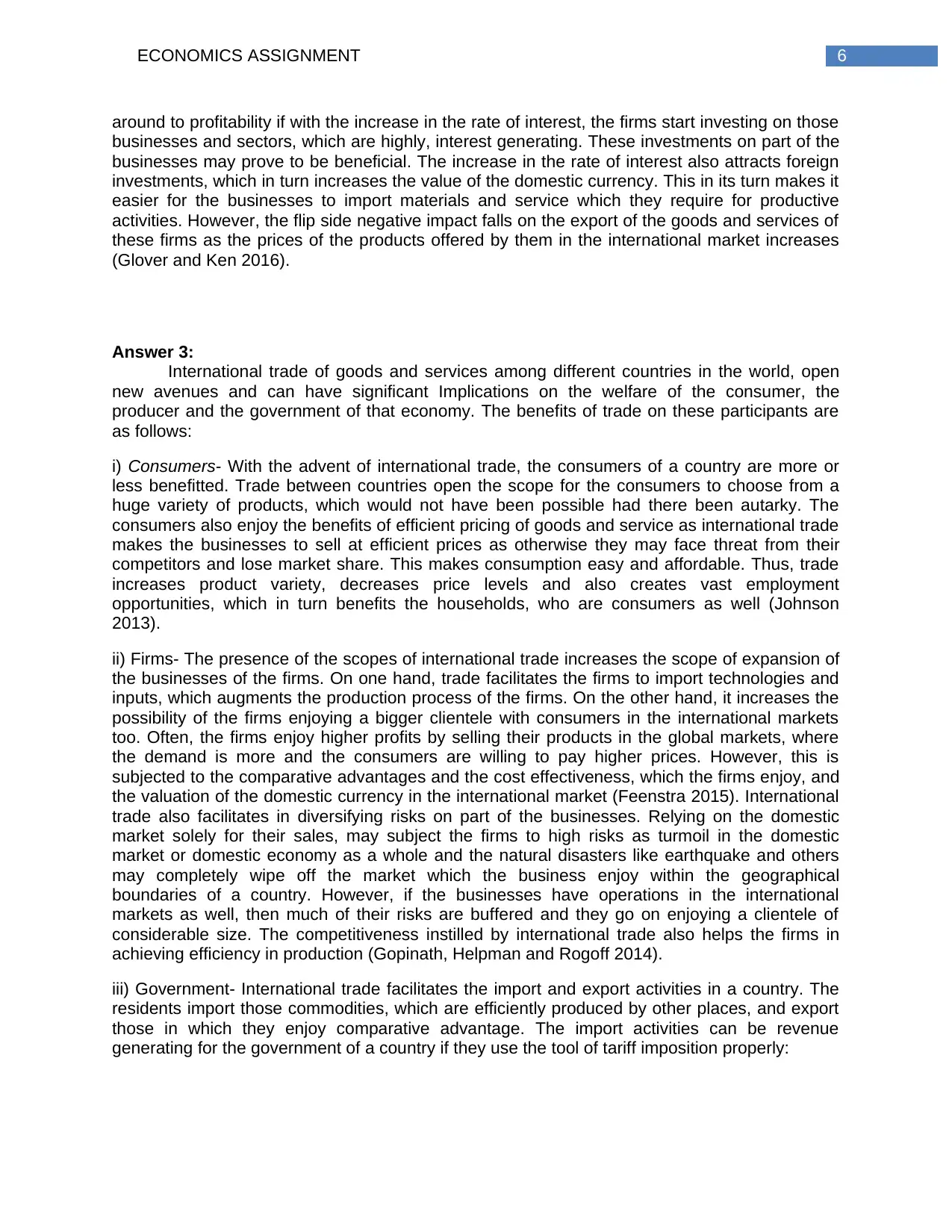
6ECONOMICS ASSIGNMENT
around to profitability if with the increase in the rate of interest, the firms start investing on those
businesses and sectors, which are highly, interest generating. These investments on part of the
businesses may prove to be beneficial. The increase in the rate of interest also attracts foreign
investments, which in turn increases the value of the domestic currency. This in its turn makes it
easier for the businesses to import materials and service which they require for productive
activities. However, the flip side negative impact falls on the export of the goods and services of
these firms as the prices of the products offered by them in the international market increases
(Glover and Ken 2016).
Answer 3:
International trade of goods and services among different countries in the world, open
new avenues and can have significant Implications on the welfare of the consumer, the
producer and the government of that economy. The benefits of trade on these participants are
as follows:
i) Consumers- With the advent of international trade, the consumers of a country are more or
less benefitted. Trade between countries open the scope for the consumers to choose from a
huge variety of products, which would not have been possible had there been autarky. The
consumers also enjoy the benefits of efficient pricing of goods and service as international trade
makes the businesses to sell at efficient prices as otherwise they may face threat from their
competitors and lose market share. This makes consumption easy and affordable. Thus, trade
increases product variety, decreases price levels and also creates vast employment
opportunities, which in turn benefits the households, who are consumers as well (Johnson
2013).
ii) Firms- The presence of the scopes of international trade increases the scope of expansion of
the businesses of the firms. On one hand, trade facilitates the firms to import technologies and
inputs, which augments the production process of the firms. On the other hand, it increases the
possibility of the firms enjoying a bigger clientele with consumers in the international markets
too. Often, the firms enjoy higher profits by selling their products in the global markets, where
the demand is more and the consumers are willing to pay higher prices. However, this is
subjected to the comparative advantages and the cost effectiveness, which the firms enjoy, and
the valuation of the domestic currency in the international market (Feenstra 2015). International
trade also facilitates in diversifying risks on part of the businesses. Relying on the domestic
market solely for their sales, may subject the firms to high risks as turmoil in the domestic
market or domestic economy as a whole and the natural disasters like earthquake and others
may completely wipe off the market which the business enjoy within the geographical
boundaries of a country. However, if the businesses have operations in the international
markets as well, then much of their risks are buffered and they go on enjoying a clientele of
considerable size. The competitiveness instilled by international trade also helps the firms in
achieving efficiency in production (Gopinath, Helpman and Rogoff 2014).
iii) Government- International trade facilitates the import and export activities in a country. The
residents import those commodities, which are efficiently produced by other places, and export
those in which they enjoy comparative advantage. The import activities can be revenue
generating for the government of a country if they use the tool of tariff imposition properly:
around to profitability if with the increase in the rate of interest, the firms start investing on those
businesses and sectors, which are highly, interest generating. These investments on part of the
businesses may prove to be beneficial. The increase in the rate of interest also attracts foreign
investments, which in turn increases the value of the domestic currency. This in its turn makes it
easier for the businesses to import materials and service which they require for productive
activities. However, the flip side negative impact falls on the export of the goods and services of
these firms as the prices of the products offered by them in the international market increases
(Glover and Ken 2016).
Answer 3:
International trade of goods and services among different countries in the world, open
new avenues and can have significant Implications on the welfare of the consumer, the
producer and the government of that economy. The benefits of trade on these participants are
as follows:
i) Consumers- With the advent of international trade, the consumers of a country are more or
less benefitted. Trade between countries open the scope for the consumers to choose from a
huge variety of products, which would not have been possible had there been autarky. The
consumers also enjoy the benefits of efficient pricing of goods and service as international trade
makes the businesses to sell at efficient prices as otherwise they may face threat from their
competitors and lose market share. This makes consumption easy and affordable. Thus, trade
increases product variety, decreases price levels and also creates vast employment
opportunities, which in turn benefits the households, who are consumers as well (Johnson
2013).
ii) Firms- The presence of the scopes of international trade increases the scope of expansion of
the businesses of the firms. On one hand, trade facilitates the firms to import technologies and
inputs, which augments the production process of the firms. On the other hand, it increases the
possibility of the firms enjoying a bigger clientele with consumers in the international markets
too. Often, the firms enjoy higher profits by selling their products in the global markets, where
the demand is more and the consumers are willing to pay higher prices. However, this is
subjected to the comparative advantages and the cost effectiveness, which the firms enjoy, and
the valuation of the domestic currency in the international market (Feenstra 2015). International
trade also facilitates in diversifying risks on part of the businesses. Relying on the domestic
market solely for their sales, may subject the firms to high risks as turmoil in the domestic
market or domestic economy as a whole and the natural disasters like earthquake and others
may completely wipe off the market which the business enjoy within the geographical
boundaries of a country. However, if the businesses have operations in the international
markets as well, then much of their risks are buffered and they go on enjoying a clientele of
considerable size. The competitiveness instilled by international trade also helps the firms in
achieving efficiency in production (Gopinath, Helpman and Rogoff 2014).
iii) Government- International trade facilitates the import and export activities in a country. The
residents import those commodities, which are efficiently produced by other places, and export
those in which they enjoy comparative advantage. The import activities can be revenue
generating for the government of a country if they use the tool of tariff imposition properly:
Paraphrase This Document
Need a fresh take? Get an instant paraphrase of this document with our AI Paraphraser
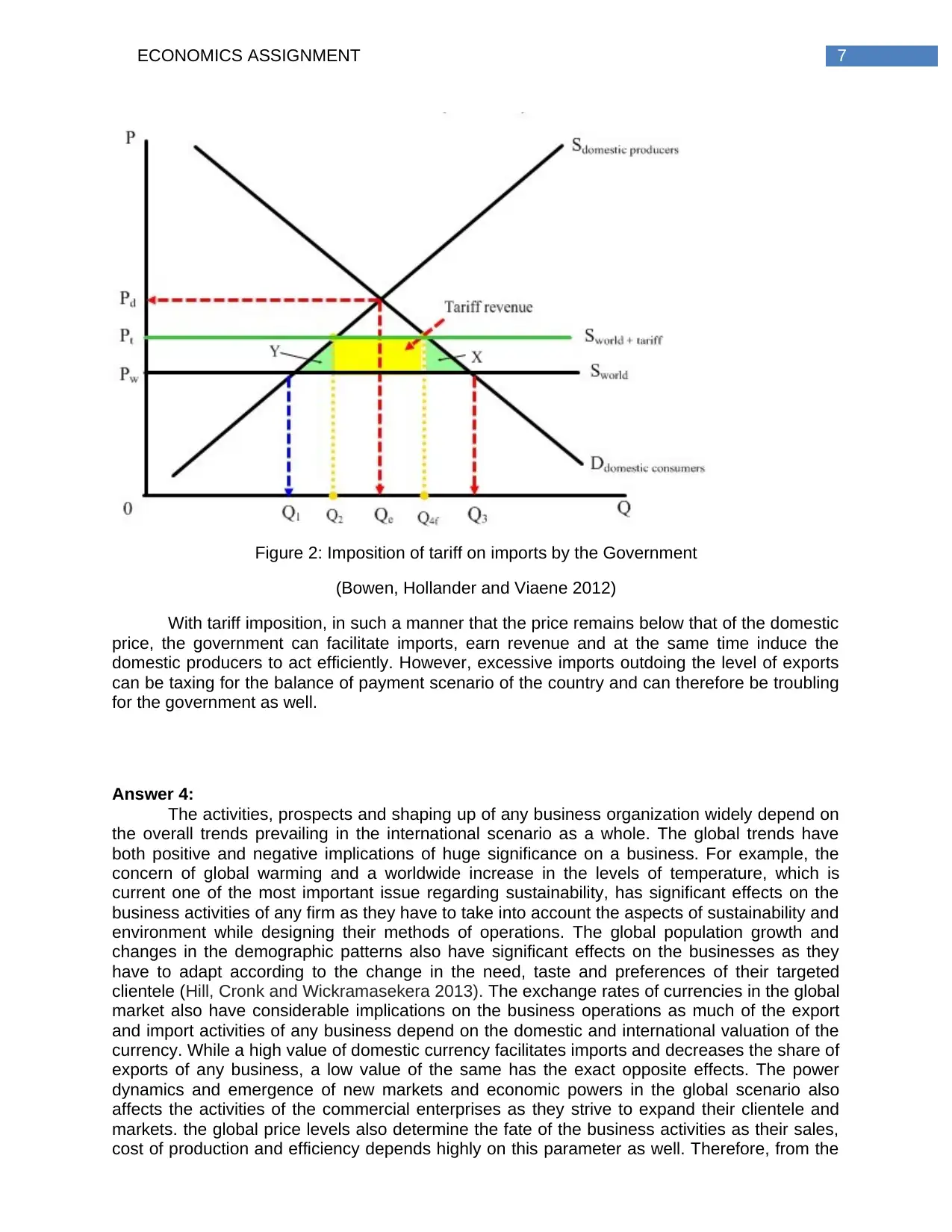
7ECONOMICS ASSIGNMENT
Figure 2: Imposition of tariff on imports by the Government
(Bowen, Hollander and Viaene 2012)
With tariff imposition, in such a manner that the price remains below that of the domestic
price, the government can facilitate imports, earn revenue and at the same time induce the
domestic producers to act efficiently. However, excessive imports outdoing the level of exports
can be taxing for the balance of payment scenario of the country and can therefore be troubling
for the government as well.
Answer 4:
The activities, prospects and shaping up of any business organization widely depend on
the overall trends prevailing in the international scenario as a whole. The global trends have
both positive and negative implications of huge significance on a business. For example, the
concern of global warming and a worldwide increase in the levels of temperature, which is
current one of the most important issue regarding sustainability, has significant effects on the
business activities of any firm as they have to take into account the aspects of sustainability and
environment while designing their methods of operations. The global population growth and
changes in the demographic patterns also have significant effects on the businesses as they
have to adapt according to the change in the need, taste and preferences of their targeted
clientele (Hill, Cronk and Wickramasekera 2013). The exchange rates of currencies in the global
market also have considerable implications on the business operations as much of the export
and import activities of any business depend on the domestic and international valuation of the
currency. While a high value of domestic currency facilitates imports and decreases the share of
exports of any business, a low value of the same has the exact opposite effects. The power
dynamics and emergence of new markets and economic powers in the global scenario also
affects the activities of the commercial enterprises as they strive to expand their clientele and
markets. the global price levels also determine the fate of the business activities as their sales,
cost of production and efficiency depends highly on this parameter as well. Therefore, from the
Figure 2: Imposition of tariff on imports by the Government
(Bowen, Hollander and Viaene 2012)
With tariff imposition, in such a manner that the price remains below that of the domestic
price, the government can facilitate imports, earn revenue and at the same time induce the
domestic producers to act efficiently. However, excessive imports outdoing the level of exports
can be taxing for the balance of payment scenario of the country and can therefore be troubling
for the government as well.
Answer 4:
The activities, prospects and shaping up of any business organization widely depend on
the overall trends prevailing in the international scenario as a whole. The global trends have
both positive and negative implications of huge significance on a business. For example, the
concern of global warming and a worldwide increase in the levels of temperature, which is
current one of the most important issue regarding sustainability, has significant effects on the
business activities of any firm as they have to take into account the aspects of sustainability and
environment while designing their methods of operations. The global population growth and
changes in the demographic patterns also have significant effects on the businesses as they
have to adapt according to the change in the need, taste and preferences of their targeted
clientele (Hill, Cronk and Wickramasekera 2013). The exchange rates of currencies in the global
market also have considerable implications on the business operations as much of the export
and import activities of any business depend on the domestic and international valuation of the
currency. While a high value of domestic currency facilitates imports and decreases the share of
exports of any business, a low value of the same has the exact opposite effects. The power
dynamics and emergence of new markets and economic powers in the global scenario also
affects the activities of the commercial enterprises as they strive to expand their clientele and
markets. the global price levels also determine the fate of the business activities as their sales,
cost of production and efficiency depends highly on this parameter as well. Therefore, from the
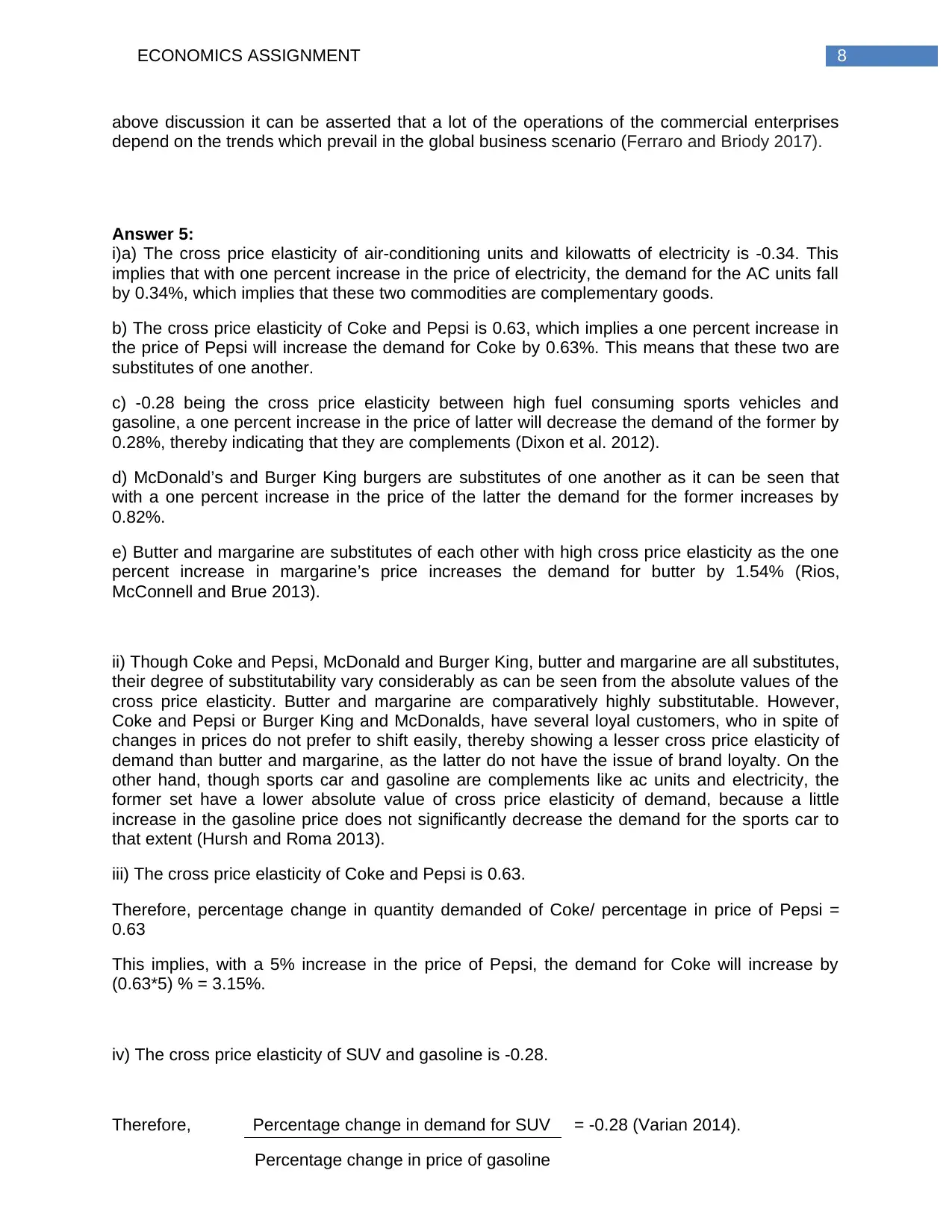
8ECONOMICS ASSIGNMENT
above discussion it can be asserted that a lot of the operations of the commercial enterprises
depend on the trends which prevail in the global business scenario (Ferraro and Briody 2017).
Answer 5:
i)a) The cross price elasticity of air-conditioning units and kilowatts of electricity is -0.34. This
implies that with one percent increase in the price of electricity, the demand for the AC units fall
by 0.34%, which implies that these two commodities are complementary goods.
b) The cross price elasticity of Coke and Pepsi is 0.63, which implies a one percent increase in
the price of Pepsi will increase the demand for Coke by 0.63%. This means that these two are
substitutes of one another.
c) -0.28 being the cross price elasticity between high fuel consuming sports vehicles and
gasoline, a one percent increase in the price of latter will decrease the demand of the former by
0.28%, thereby indicating that they are complements (Dixon et al. 2012).
d) McDonald’s and Burger King burgers are substitutes of one another as it can be seen that
with a one percent increase in the price of the latter the demand for the former increases by
0.82%.
e) Butter and margarine are substitutes of each other with high cross price elasticity as the one
percent increase in margarine’s price increases the demand for butter by 1.54% (Rios,
McConnell and Brue 2013).
ii) Though Coke and Pepsi, McDonald and Burger King, butter and margarine are all substitutes,
their degree of substitutability vary considerably as can be seen from the absolute values of the
cross price elasticity. Butter and margarine are comparatively highly substitutable. However,
Coke and Pepsi or Burger King and McDonalds, have several loyal customers, who in spite of
changes in prices do not prefer to shift easily, thereby showing a lesser cross price elasticity of
demand than butter and margarine, as the latter do not have the issue of brand loyalty. On the
other hand, though sports car and gasoline are complements like ac units and electricity, the
former set have a lower absolute value of cross price elasticity of demand, because a little
increase in the gasoline price does not significantly decrease the demand for the sports car to
that extent (Hursh and Roma 2013).
iii) The cross price elasticity of Coke and Pepsi is 0.63.
Therefore, percentage change in quantity demanded of Coke/ percentage in price of Pepsi =
0.63
This implies, with a 5% increase in the price of Pepsi, the demand for Coke will increase by
(0.63*5) % = 3.15%.
iv) The cross price elasticity of SUV and gasoline is -0.28.
Therefore, Percentage change in demand for SUV = -0.28 (Varian 2014).
Percentage change in price of gasoline
above discussion it can be asserted that a lot of the operations of the commercial enterprises
depend on the trends which prevail in the global business scenario (Ferraro and Briody 2017).
Answer 5:
i)a) The cross price elasticity of air-conditioning units and kilowatts of electricity is -0.34. This
implies that with one percent increase in the price of electricity, the demand for the AC units fall
by 0.34%, which implies that these two commodities are complementary goods.
b) The cross price elasticity of Coke and Pepsi is 0.63, which implies a one percent increase in
the price of Pepsi will increase the demand for Coke by 0.63%. This means that these two are
substitutes of one another.
c) -0.28 being the cross price elasticity between high fuel consuming sports vehicles and
gasoline, a one percent increase in the price of latter will decrease the demand of the former by
0.28%, thereby indicating that they are complements (Dixon et al. 2012).
d) McDonald’s and Burger King burgers are substitutes of one another as it can be seen that
with a one percent increase in the price of the latter the demand for the former increases by
0.82%.
e) Butter and margarine are substitutes of each other with high cross price elasticity as the one
percent increase in margarine’s price increases the demand for butter by 1.54% (Rios,
McConnell and Brue 2013).
ii) Though Coke and Pepsi, McDonald and Burger King, butter and margarine are all substitutes,
their degree of substitutability vary considerably as can be seen from the absolute values of the
cross price elasticity. Butter and margarine are comparatively highly substitutable. However,
Coke and Pepsi or Burger King and McDonalds, have several loyal customers, who in spite of
changes in prices do not prefer to shift easily, thereby showing a lesser cross price elasticity of
demand than butter and margarine, as the latter do not have the issue of brand loyalty. On the
other hand, though sports car and gasoline are complements like ac units and electricity, the
former set have a lower absolute value of cross price elasticity of demand, because a little
increase in the gasoline price does not significantly decrease the demand for the sports car to
that extent (Hursh and Roma 2013).
iii) The cross price elasticity of Coke and Pepsi is 0.63.
Therefore, percentage change in quantity demanded of Coke/ percentage in price of Pepsi =
0.63
This implies, with a 5% increase in the price of Pepsi, the demand for Coke will increase by
(0.63*5) % = 3.15%.
iv) The cross price elasticity of SUV and gasoline is -0.28.
Therefore, Percentage change in demand for SUV = -0.28 (Varian 2014).
Percentage change in price of gasoline
⊘ This is a preview!⊘
Do you want full access?
Subscribe today to unlock all pages.

Trusted by 1+ million students worldwide
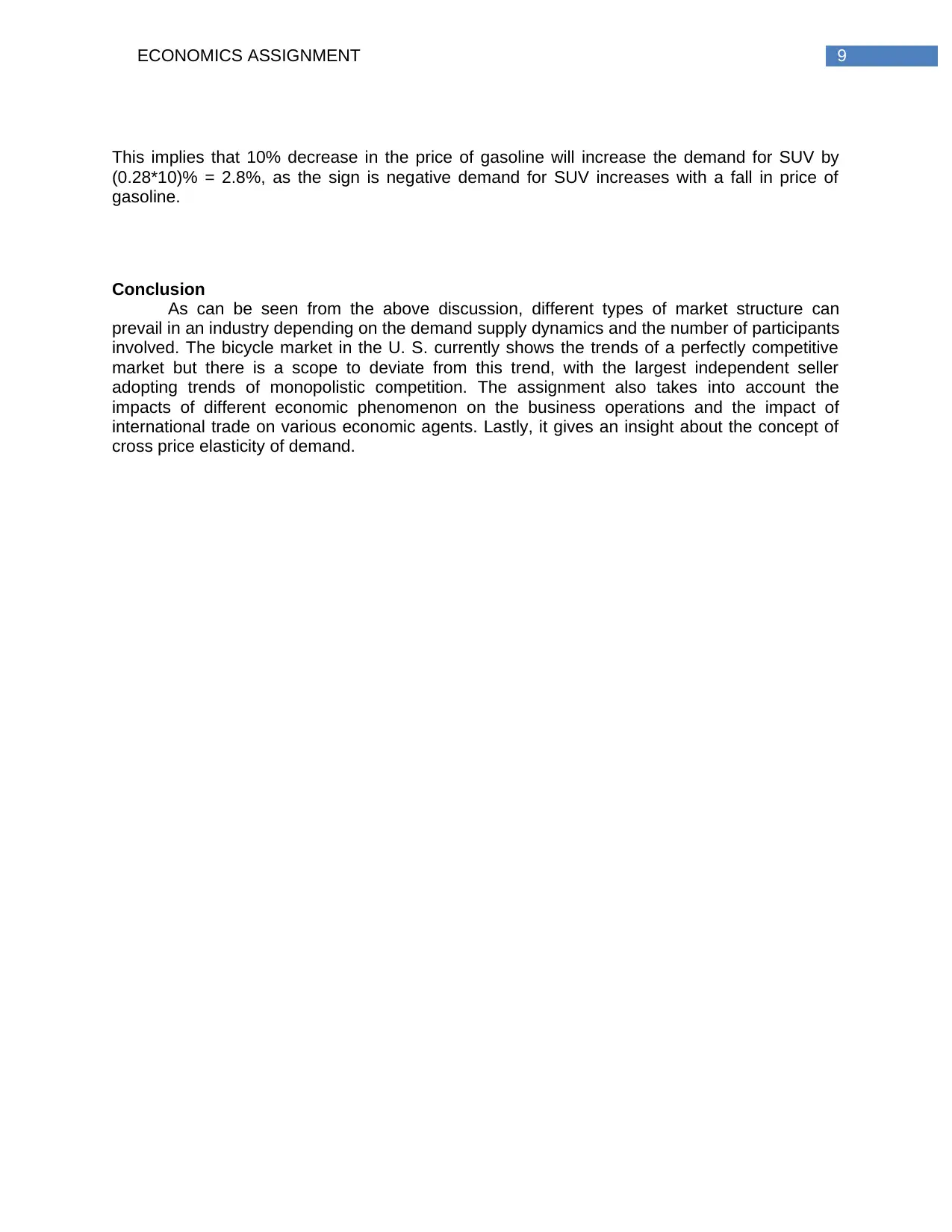
9ECONOMICS ASSIGNMENT
This implies that 10% decrease in the price of gasoline will increase the demand for SUV by
(0.28*10)% = 2.8%, as the sign is negative demand for SUV increases with a fall in price of
gasoline.
Conclusion
As can be seen from the above discussion, different types of market structure can
prevail in an industry depending on the demand supply dynamics and the number of participants
involved. The bicycle market in the U. S. currently shows the trends of a perfectly competitive
market but there is a scope to deviate from this trend, with the largest independent seller
adopting trends of monopolistic competition. The assignment also takes into account the
impacts of different economic phenomenon on the business operations and the impact of
international trade on various economic agents. Lastly, it gives an insight about the concept of
cross price elasticity of demand.
This implies that 10% decrease in the price of gasoline will increase the demand for SUV by
(0.28*10)% = 2.8%, as the sign is negative demand for SUV increases with a fall in price of
gasoline.
Conclusion
As can be seen from the above discussion, different types of market structure can
prevail in an industry depending on the demand supply dynamics and the number of participants
involved. The bicycle market in the U. S. currently shows the trends of a perfectly competitive
market but there is a scope to deviate from this trend, with the largest independent seller
adopting trends of monopolistic competition. The assignment also takes into account the
impacts of different economic phenomenon on the business operations and the impact of
international trade on various economic agents. Lastly, it gives an insight about the concept of
cross price elasticity of demand.
Paraphrase This Document
Need a fresh take? Get an instant paraphrase of this document with our AI Paraphraser
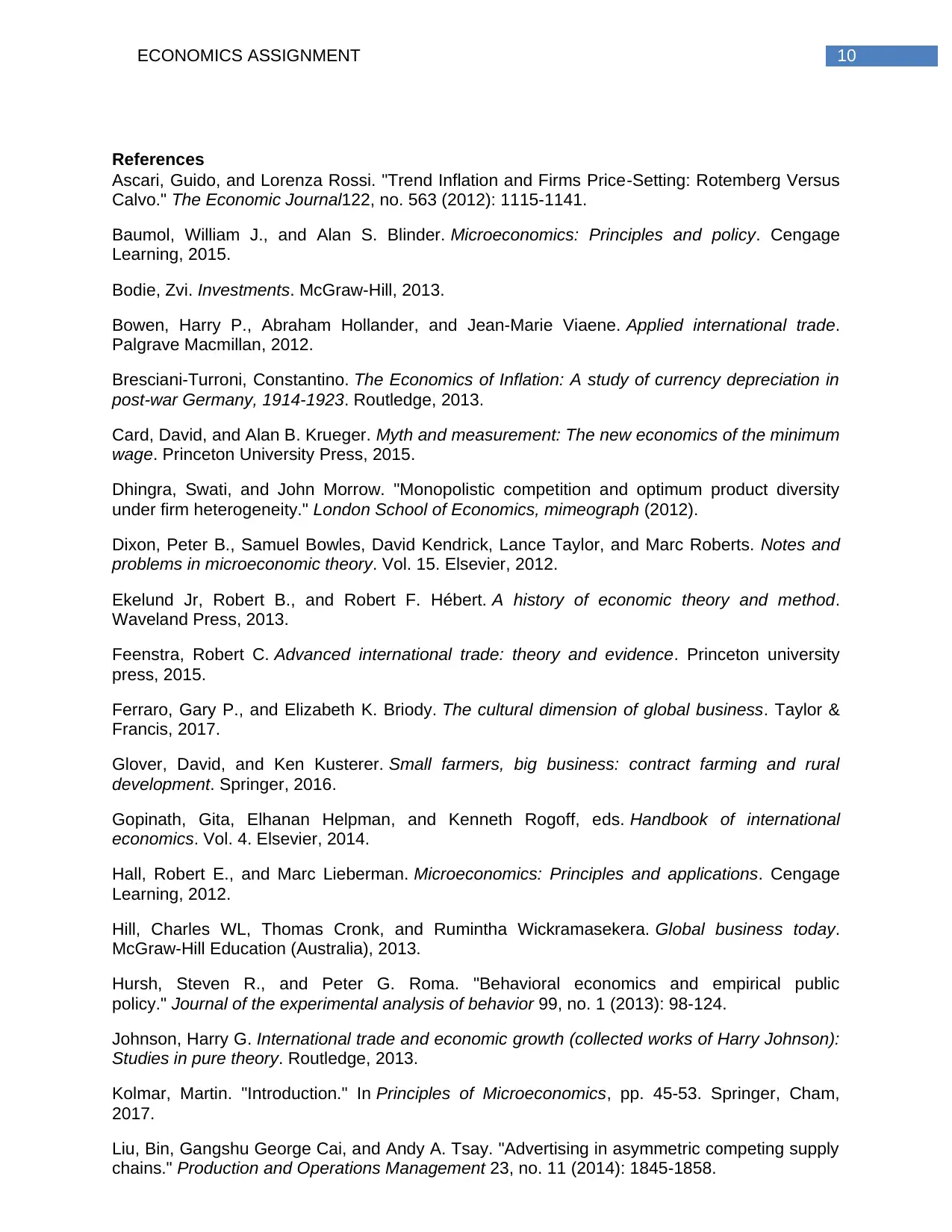
10ECONOMICS ASSIGNMENT
References
Ascari, Guido, and Lorenza Rossi. "Trend Inflation and Firms Price‐Setting: Rotemberg Versus
Calvo." The Economic Journal122, no. 563 (2012): 1115-1141.
Baumol, William J., and Alan S. Blinder. Microeconomics: Principles and policy. Cengage
Learning, 2015.
Bodie, Zvi. Investments. McGraw-Hill, 2013.
Bowen, Harry P., Abraham Hollander, and Jean-Marie Viaene. Applied international trade.
Palgrave Macmillan, 2012.
Bresciani-Turroni, Constantino. The Economics of Inflation: A study of currency depreciation in
post-war Germany, 1914-1923. Routledge, 2013.
Card, David, and Alan B. Krueger. Myth and measurement: The new economics of the minimum
wage. Princeton University Press, 2015.
Dhingra, Swati, and John Morrow. "Monopolistic competition and optimum product diversity
under firm heterogeneity." London School of Economics, mimeograph (2012).
Dixon, Peter B., Samuel Bowles, David Kendrick, Lance Taylor, and Marc Roberts. Notes and
problems in microeconomic theory. Vol. 15. Elsevier, 2012.
Ekelund Jr, Robert B., and Robert F. Hébert. A history of economic theory and method.
Waveland Press, 2013.
Feenstra, Robert C. Advanced international trade: theory and evidence. Princeton university
press, 2015.
Ferraro, Gary P., and Elizabeth K. Briody. The cultural dimension of global business. Taylor &
Francis, 2017.
Glover, David, and Ken Kusterer. Small farmers, big business: contract farming and rural
development. Springer, 2016.
Gopinath, Gita, Elhanan Helpman, and Kenneth Rogoff, eds. Handbook of international
economics. Vol. 4. Elsevier, 2014.
Hall, Robert E., and Marc Lieberman. Microeconomics: Principles and applications. Cengage
Learning, 2012.
Hill, Charles WL, Thomas Cronk, and Rumintha Wickramasekera. Global business today.
McGraw-Hill Education (Australia), 2013.
Hursh, Steven R., and Peter G. Roma. "Behavioral economics and empirical public
policy." Journal of the experimental analysis of behavior 99, no. 1 (2013): 98-124.
Johnson, Harry G. International trade and economic growth (collected works of Harry Johnson):
Studies in pure theory. Routledge, 2013.
Kolmar, Martin. "Introduction." In Principles of Microeconomics, pp. 45-53. Springer, Cham,
2017.
Liu, Bin, Gangshu George Cai, and Andy A. Tsay. "Advertising in asymmetric competing supply
chains." Production and Operations Management 23, no. 11 (2014): 1845-1858.
References
Ascari, Guido, and Lorenza Rossi. "Trend Inflation and Firms Price‐Setting: Rotemberg Versus
Calvo." The Economic Journal122, no. 563 (2012): 1115-1141.
Baumol, William J., and Alan S. Blinder. Microeconomics: Principles and policy. Cengage
Learning, 2015.
Bodie, Zvi. Investments. McGraw-Hill, 2013.
Bowen, Harry P., Abraham Hollander, and Jean-Marie Viaene. Applied international trade.
Palgrave Macmillan, 2012.
Bresciani-Turroni, Constantino. The Economics of Inflation: A study of currency depreciation in
post-war Germany, 1914-1923. Routledge, 2013.
Card, David, and Alan B. Krueger. Myth and measurement: The new economics of the minimum
wage. Princeton University Press, 2015.
Dhingra, Swati, and John Morrow. "Monopolistic competition and optimum product diversity
under firm heterogeneity." London School of Economics, mimeograph (2012).
Dixon, Peter B., Samuel Bowles, David Kendrick, Lance Taylor, and Marc Roberts. Notes and
problems in microeconomic theory. Vol. 15. Elsevier, 2012.
Ekelund Jr, Robert B., and Robert F. Hébert. A history of economic theory and method.
Waveland Press, 2013.
Feenstra, Robert C. Advanced international trade: theory and evidence. Princeton university
press, 2015.
Ferraro, Gary P., and Elizabeth K. Briody. The cultural dimension of global business. Taylor &
Francis, 2017.
Glover, David, and Ken Kusterer. Small farmers, big business: contract farming and rural
development. Springer, 2016.
Gopinath, Gita, Elhanan Helpman, and Kenneth Rogoff, eds. Handbook of international
economics. Vol. 4. Elsevier, 2014.
Hall, Robert E., and Marc Lieberman. Microeconomics: Principles and applications. Cengage
Learning, 2012.
Hill, Charles WL, Thomas Cronk, and Rumintha Wickramasekera. Global business today.
McGraw-Hill Education (Australia), 2013.
Hursh, Steven R., and Peter G. Roma. "Behavioral economics and empirical public
policy." Journal of the experimental analysis of behavior 99, no. 1 (2013): 98-124.
Johnson, Harry G. International trade and economic growth (collected works of Harry Johnson):
Studies in pure theory. Routledge, 2013.
Kolmar, Martin. "Introduction." In Principles of Microeconomics, pp. 45-53. Springer, Cham,
2017.
Liu, Bin, Gangshu George Cai, and Andy A. Tsay. "Advertising in asymmetric competing supply
chains." Production and Operations Management 23, no. 11 (2014): 1845-1858.
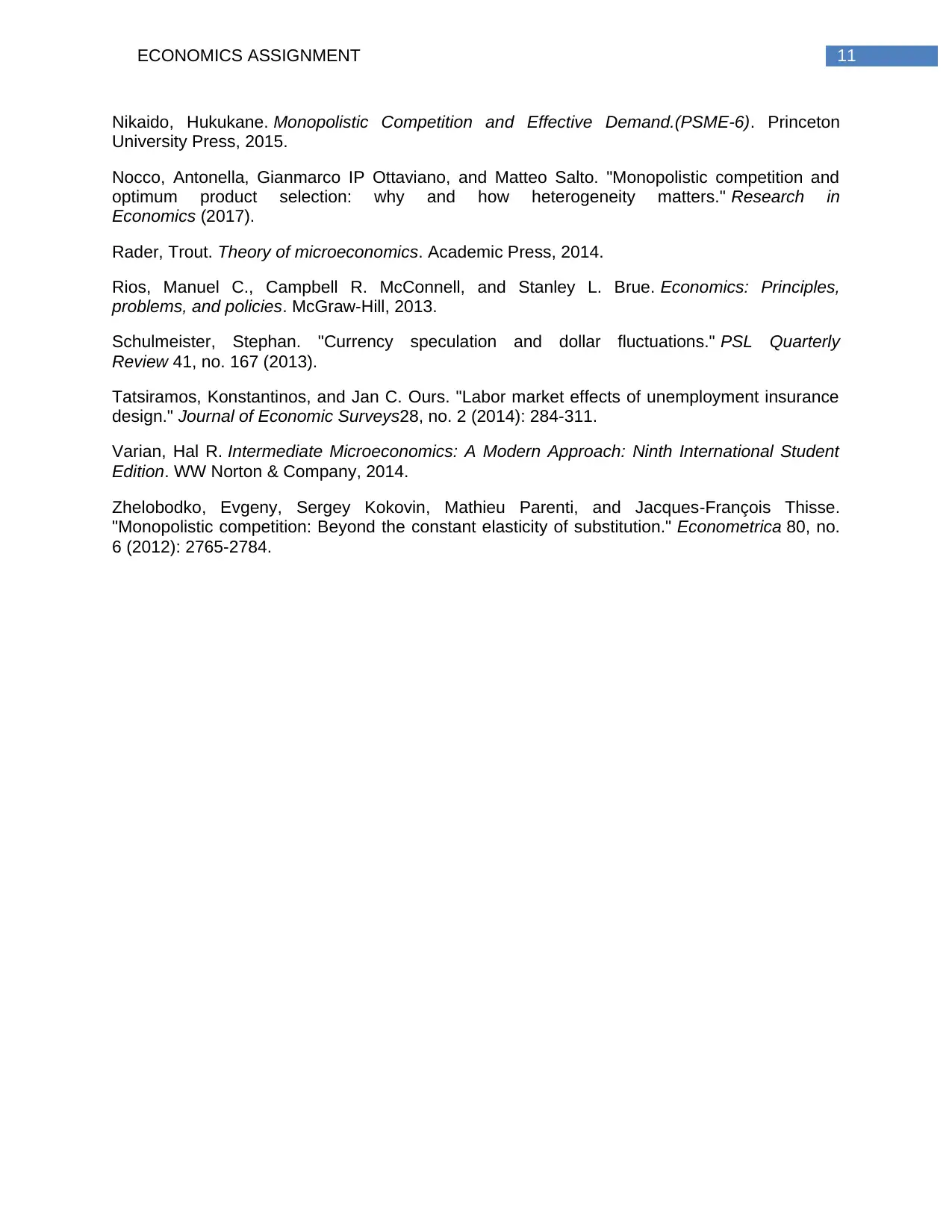
11ECONOMICS ASSIGNMENT
Nikaido, Hukukane. Monopolistic Competition and Effective Demand.(PSME-6). Princeton
University Press, 2015.
Nocco, Antonella, Gianmarco IP Ottaviano, and Matteo Salto. "Monopolistic competition and
optimum product selection: why and how heterogeneity matters." Research in
Economics (2017).
Rader, Trout. Theory of microeconomics. Academic Press, 2014.
Rios, Manuel C., Campbell R. McConnell, and Stanley L. Brue. Economics: Principles,
problems, and policies. McGraw-Hill, 2013.
Schulmeister, Stephan. "Currency speculation and dollar fluctuations." PSL Quarterly
Review 41, no. 167 (2013).
Tatsiramos, Konstantinos, and Jan C. Ours. "Labor market effects of unemployment insurance
design." Journal of Economic Surveys28, no. 2 (2014): 284-311.
Varian, Hal R. Intermediate Microeconomics: A Modern Approach: Ninth International Student
Edition. WW Norton & Company, 2014.
Zhelobodko, Evgeny, Sergey Kokovin, Mathieu Parenti, and Jacques‐François Thisse.
"Monopolistic competition: Beyond the constant elasticity of substitution." Econometrica 80, no.
6 (2012): 2765-2784.
Nikaido, Hukukane. Monopolistic Competition and Effective Demand.(PSME-6). Princeton
University Press, 2015.
Nocco, Antonella, Gianmarco IP Ottaviano, and Matteo Salto. "Monopolistic competition and
optimum product selection: why and how heterogeneity matters." Research in
Economics (2017).
Rader, Trout. Theory of microeconomics. Academic Press, 2014.
Rios, Manuel C., Campbell R. McConnell, and Stanley L. Brue. Economics: Principles,
problems, and policies. McGraw-Hill, 2013.
Schulmeister, Stephan. "Currency speculation and dollar fluctuations." PSL Quarterly
Review 41, no. 167 (2013).
Tatsiramos, Konstantinos, and Jan C. Ours. "Labor market effects of unemployment insurance
design." Journal of Economic Surveys28, no. 2 (2014): 284-311.
Varian, Hal R. Intermediate Microeconomics: A Modern Approach: Ninth International Student
Edition. WW Norton & Company, 2014.
Zhelobodko, Evgeny, Sergey Kokovin, Mathieu Parenti, and Jacques‐François Thisse.
"Monopolistic competition: Beyond the constant elasticity of substitution." Econometrica 80, no.
6 (2012): 2765-2784.
⊘ This is a preview!⊘
Do you want full access?
Subscribe today to unlock all pages.

Trusted by 1+ million students worldwide
1 out of 12
Related Documents
Your All-in-One AI-Powered Toolkit for Academic Success.
+13062052269
info@desklib.com
Available 24*7 on WhatsApp / Email
![[object Object]](/_next/static/media/star-bottom.7253800d.svg)
Unlock your academic potential
Copyright © 2020–2025 A2Z Services. All Rights Reserved. Developed and managed by ZUCOL.





